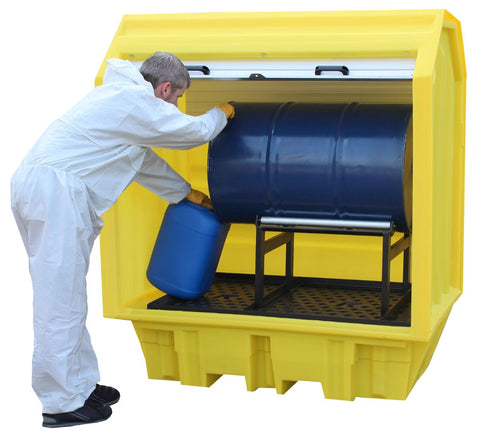Workplace Safety Facts and Statistics
Workplace-related injury is shockingly high in the UK. And statistics from the Health & Safety Executive (HSE) show that thousands of UK workers are injured or killed on the job every year due to preventable accidents.
And hopefully, you're sitting down because 36.8 million working days were lost due to work-related illness and injury between 2021 and 2022! In total, a shocking 123 workers were killed in workplace accidents, and 565,000 were injured.
So, employers need to be aware of the latest facts and statistics and take necessary steps to ensure the safety of their workers.
This article explores critical workplace safety facts and statistics, with suggestions regarding how employers can create a safer work environment.
What is the most common cause of workplace accidents in the UK?
Slips, trips and falls are the most common cause of workplace accidents in the UK, accounting for over 40% of all reported non-fatal injuries.
This is followed by:
- Being hit by a moving object, including falling objects, machine/knife cuts, runaway trolleys
- Falling from height: accounting for 26% of deaths in the workplace (mainly from ladders).
- Manual handling: mainly injuries from lifting, carrying, or handling items, leading to back injuries, strains, or serious accidents.
- Being struck by a moving vehicle, including pallet trucks and warehouse vans
Why are ladders so dangerous in the workplace?
Most ladder-related injuries are due to slipping from a rung or improper stabilisation.
When workers are up and down ladders all day, it's essential to mitigate the risks they face due to environmental factors.
For example, most builders work outside in all weathers, and muddy boots and ladder rungs aren't always compatible. You can mitigate this risk by providing high-quality construction site matting so workers can wipe their feet before climbing ladders.
Additionally, appropriate training can help reduce the number of ladder accidents due to unstable footing. In addition to training, ensuring workers have the right protective gear, such as sturdy workwear trousers with reinforced knee protection can help minimize risks and provide better durability for demanding tasks. Learn the 1 to 4 rule of ladder usage, which helps users set their ladders up correctly for maximum safety.
How many workplace injuries are fatal in the UK each year?
According to the Health and Safety Executive, there were 123 fatal workplace injuries in 2021-2022 in the UK. This was a decrease of 22 fatalities from 2020-2021.
The majority of fatalities (79%) were accounted for by five different types of accidents, which includes:
- Falls from height — 29 deaths
- Being struck by a moving vehicle — 23 deaths
- Being hit by a moving, flying or falling object — 18 deaths
- Contact with moving machinery — 15 deaths
- Trapped after something collapsed or overturned — 14 deaths
In addition to employees who died in accidents, eighty members of the public were killed from workplace accidents.
Which industry by sector has the most non-fatal injuries?
According to the HSE’s most recent Labour Force Survey, the industry sector with the most reported workplace injuries in the UK is agriculture, forestry, and fishing, with 4100 (per 100,000 workers) self-reported non-fatal workplace injuries between 2021/22.
Construction comes second with 2880 (per 100,000 workers), and accommodation and food services third, with 2420 (per 100,000 workers). This is closely followed by the manufacturing sector, which accounts for around 23% of all reported cases.
The industries with the most fatalities were agriculture, with 22 deaths, and manufacturing, also at 22.
So which industry has the unenviable title of the UK's most dangerous industry to work in? The answer is Agriculture, Forestry and Fishing, which has the highest rate of fatal injuries.

What is the most important factor in workplace safety?
The most crucial factor in UK workplace safety is the prevention of accidents and injuries. This includes:
- Identifying and managing risks associated with work activities
- Providing appropriate training and supervision
- Ensuring that machinery and equipment are properly maintained and used
- Promoting a positive safety culture within the workplace
The HSE is the UK government's agency responsible for enforcing workplace health and safety regulations. It works with employers to improve safety standards and reduce the volume of accidents and injuries in the workplace.
What are the 5 benefits of workplace health and safety?
There are many reasons to safeguard workplace health and safety. However, here are five of the biggest benefits of promoting a safety-first working environment:
- Reduced injuries and illnesses: By implementing effective health and safety measures, employers can help prevent workplace accidents and illnesses. This helps reduce the number of injuries and illnesses, which can lead to reduced absenteeism, lower medical costs, and increased productivity.
- Improved employee morale: When employees feel safe and secure in their workplace, it can enhance their overall morale and job satisfaction. This can increase employee engagement, improve teamwork, and higher productivity.
- Reduced costs: Workplace injuries and illnesses can be costly for employers in terms of medical expenses and lost productivity. Employers can help reduce these costs and improve their bottom line by implementing effective health and safety measures.
- Improved reputation: Employers prioritising workplace health and safety can improve their reputation as responsible and caring employers. This can help attract and retain talented employees and improve relationships with customers and suppliers.
- Compliance with regulations: Employers that comply with health and safety regulations can avoid fines and legal action, which can be costly and damage their reputation. By prioritising workplace health and safety, employers can ensure that they meet their legal obligations and protect their employees.
So, how do you prevent accidents in the workplace?
There are several measures a business can put in place to ensure a safer working environment for all employees.
These include:
Anti-slip matting
Slips, trips, and falls are the most common workplace injury, but you can overcome the causes with an appropriate risk assessment.
Installing anti-slip matting, appropriate workshop matting, anti-slip tape, GRP nosing, and stair treads help prevent slips. And simple measures such as proper entrance matting help keep the working environment clean and safe.

Spillage control
Spills aren’t always preventable, especially in manufacturing environments, so it’s essential to have appropriate spill-cleaning kits on hand to address spills, leaks, and drips as quickly as they appear.
Always ensure that your spill kit is appropriate for the required cleaning task — oil spillages need different cleaning products to chemical or water spills.
Training
Training is one of the best ways to minimise workplace accidents. Although many safety measures may seem like a case of simple common sense, it's essential to remind colleagues of the dangers they face. It's easy for workers to lose concentration, especially with repetitive tasks, which is when accidents happen.
You can help your workforce maintain their concentration throughout their shift with anti-fatigue matting, which helps take pressure off the joints and limbs, especially during long periods of standing.
Also, a regular safety refreshment course can pay dividends. Additionally, employees must handle machinery safely without taking shortcuts — reinforcing the safe operation of machinery will also prevent accidents and risks.
Workplace Safety Facts and Statistics Summary
Workplace safety is a critical aspect of any business or organisation. By prioritising employee health and safety, employers can prevent workplace accidents and injuries and improve employee morale, reduce costs, and enhance their reputation.
The statistics and facts we've explored in this article highlight the importance of implementing effective health and safety measures and promoting a positive safety culture within the workplace.
So, employers must take proactive steps to identify and manage risks, provide appropriate training and supervision, and ensure that equipment and machinery are properly maintained and used.
Ultimately, investing in workplace safety benefits both employers and employees, and it is a critical aspect of building a successful and sustainable business.
Get in touch, and we’ll be happy to help improve your workplace’s safety credentials.



